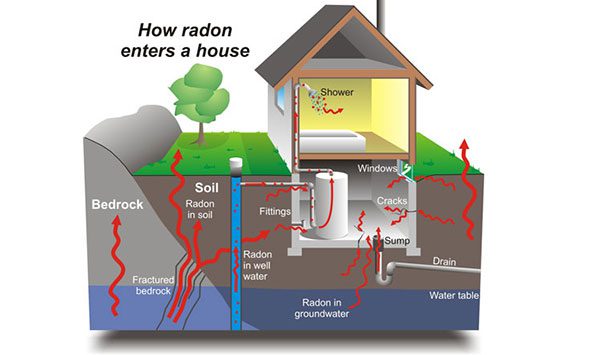Unlike several other carcinogens, radon cannot be detected by human measures
 As homeowners, our ultimate goal is to provide ourselves and our families with a safe place to live. Unfortunately, some homeowners don’t realize that some of the most substantial threats to their family’s well-being are not the physical ones – like intruders – but ones related to their health.
As homeowners, our ultimate goal is to provide ourselves and our families with a safe place to live. Unfortunately, some homeowners don’t realize that some of the most substantial threats to their family’s well-being are not the physical ones – like intruders – but ones related to their health.
Radon exposure is one of the most urgent issues a homeowner will face in keeping their loved ones safe, and the only way to protect them is by staying ahead of the threat.
Radon is a gas that is the product of the radioactive decay of uranium in rocks and soil. Although the compound occurs naturally in the atmosphere in trace amounts, it can become a significant human health hazard as it is drawn into homes and other buildings through openings and cracks in the foundation. All types of houses can have high indoor radon – old or new, with or without basements, drafty or well insulated; the only way to know is to test.
| Click image for larger view of how radon enters your home |
 |
| More on Cancers |
| New clue discovered for how and why cancer cells spread
|
| Free, easy-to-use tool could reduce unnecessary prostate cancer biopsies
|
| Exercise may be essential part of treating cancer
|
Research from the U.S. Environmental Protection Agency of data from around the world finds that radon is the leading cause of lung cancer among non-smokers and the second most prominent cause of cancer overall, behind only smoking. As such, homeowners are right to be concerned about the danger radon poses to them and their families.
When someone breathes in radon gas, the radioactive particles become lodged in their lung tissue, releasing alpha particles directly into the lung cells. Over time, this can cause significant damage to the lungs. Studies have shown that the risk of being exposed to 4.0 pCi/L (picocuries per litre of air) of radon gas is equivalent to having 400 chest X-rays yearly or smoking eight cigarettes daily. As a result, approximately 14 per cent of all lung cancer cases are attributable to radon gas.
Unlike several other carcinogens, radon cannot be detected by human measures. It is an odourless, tasteless, and colourless gas, meaning that the only way for someone to determine the radon level in their home is through testing – hence the name “the silent killer.” Still, specialized sensor technology is available to consumers and professionals to allow them to measure radon levels in homes.
However, a single test is not enough to accurately assess the risk faced from radon exposure. Radon levels can fluctuate significantly due to several factors, such as seasonal and daily temperature and atmospheric pressure changes, which affect the rate at which the gas is pulled from the soil into a home. Regular testing over a period of a week or more – ideally continuously monitoring – is the only way to precisely determine a home’s radon levels.
Thankfully, more electronic consumer radon detectors (including ours) are hitting the market, allowing homeowners to get fast and reliable results. These affordable devices are a perfect first step for concerned homeowners, as they can be set up to alert homeowners when radon levels have reached an actionable point, and the assistance of a radon professional must be enlisted.
When a home’s radon level tests above 4.0 pCi/L – or even between 2.0 and 4.0 pCi/L – homeowners should contact a certified radon specialist to diagnose their home and establish a plan for remediation efforts. Affordable measures may include increasing the home’s ventilation or drawing the radon gas from below the house and venting it through a pipe to the air above the roof, where it can quickly dilute.
Radon-induced lung cancer is preventable. The best way to address radon exposure is not to allow it in the first place. Homeowners should be proactive in continuously monitoring their home’s radon levels using an affordable, high-quality consumer testing device and taking remedial action if necessary. Even if the radon levels in their home never reach actionable levels, it is worth investing in a radon testing device if only for the added peace of mind it can provide.
Insoo Park is the Founder and CEO of Ecosense, a leader and trusted provider of radon-detecting and monitoring solutions.
For interview requests, click here.
The opinions expressed by our columnists and contributors are theirs alone and do not inherently or expressly reflect the views of our publication.
© Troy Media
Troy Media is an editorial content provider to media outlets and its own hosted community news outlets across Canada.

